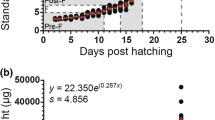Summary
(1) Scanning electron microscopy and vascular casting were used to study the morphology and vascular anatomy of the fully developed internal gills of Litoria ewingii tadpoles. — (2) The four pairs of gills were located in two branchial baskets on either side of the heart. Each gill consisted of a branchial arch with gill tufts projecting ventrally and gill filters running dorsally. The gills bore a variable number of gill tufts in which a complex three-dimensional array of capillary loops, of varying lengths and diameters, was trailed in the path of the ventilatory current. — (3) The evidence presented in this paper suggests that the gill tufts have greater potential as gas exchangers than either the gill filters or skin. — (4) The study revealed structural and functional evidence for the existence of branchial shunts between afferent and efferent branchial arteries.
Similar content being viewed by others
References
Boas JEV (1882) Über den Conus Arteriosus und die Arterienbogen der Amphibien. Morphol Jahrb 7:488–572
Burggren WW, West NH (1982) Changing respiratory importance of gills, lungs and skin during metamorphosis in the bullfrog Rana catesbeiana. Respir Physiol 47:151–164
Calori A (1842) Descriptio anatom. branchiarum. Novi comment Acad Sci Inst Bononien 5:111 (Cited in Kenny, 1969a)
Czopek J (1957) The vascularisation of respiratory surfaces in Ambystoma mexicanum (Cope) in ontogeny. Zool Polon 8:131–149
Czopek J (1965) Quantitative studies on the morphology of the respiratory surfaces in amphibians. Acta Anat 62:296–323
de Saint-Aubain ML (1981) Shunts in the gill filament in tadpoles of Rana temporaria and Bufo bufo (Amphibia, Anura). J Exp Zool 217:143–145
de Saint-Aubain ML (1982) The morphology of amphibian skin vascularisation before and after metamorphosis. Zoomorphology 100:55–63
Duméril AMC, Bibron G (1841) Erpétologie générale ou histoire naturelle complète des reptiles. Roret, Paris
Farrell AP (1980) Gill morphometrics, vessel dimensions, and vascular resistance in ling cod, Ophiodon elongatus. Can J Zool 58:807–818
Figge FHJ (1936) The differential reaction of the blood vessels of a branchial arch of Amblystoma tigrinum (Colorado Axolotl). 1. The reaction to adrenaline, oxygen and CO2. Physiol Zool 9:79–101
Goette A (1874) Atlas zur Entwicklungsgeschichte der Unke. Leipzig (Cited in Kenny 1969a)
Goette A (1875) Die Entwicklungsgeschichte der Unke. 1:964, Leipzig (Cited in Kenny 1969a)
Gosner KL (1960) A simplified table for staging anuran embryos and larvae with notes on identification. Herpetologica 16:183–190
Gradwell N (1969) The respiratory importance of the tadpole operculum in Rana catesbeiana. Can J Zool 47:1239–1243
Gradwell N (1972a) Gill irrigation in Rana catesheiana. Part I. On the anatomical basis. Can J Zool 50:481–499
Gradwell N (1972b) Gill irrigation in Rana catesbeiana. Part II. On the musculoskeletal mechanism. Can J Zool 50:501–521
Just JJ, Gatz RN, Crawford EC Jr (1973) Changes in respiratory functions during metamorphosis of the bullfrog, Rana catesbeiana. Respir Physiol 17:276–282
Kenny JS (1969a) Feeding mechanisms in anuran larvae. J Zool London 157:225–246
Kenny JS (1969b) Pharyngeal mucous secreting epithelium of anuran larvae. Acta Zool 50:143–153
Marshall AM (1893) The development of the frog. In: Vertebrate Embryology. Smith, Elder & Co, London, pp 160–185
Marshall AM (1932) The frog: an introduction to anatomy, histology and embryology. Macmillan & Co Ltd, London, pp 131–140
Millard N (1945) The development of the arterial system of Xenopus laevis, including experiments on the destruction of the larval arches. Trans R Soc S Afr 30:217–234
Nonnotte G (1981) Cutaneous respiration in six freshwater teleosts. Comp Biochem Physiol 70A:541–544
Piiper J, Scheid P (1972) Maximum gas transfer efficacy of models for fish gills, avian lungs and mammalian lungs. Respir Physiol 14:115–124
Rugh R (1951) The frog: its reproduction and development. McGraw-Hill Book Co, New York Toronto London
Rusconi M (1826) Development de la grenouille commune depuis de moment de sa naissance jusq'a son etat parfait. Paris (Cited in Kenny 1969a)
Savage RM (1961) The relation between the ecology of tadpoles and their anatomy and physiology, pp 44–57. In: The ecology and life history of the common frog (Rana temporaria temporaria). Pitman & Sons Ltd, London
Satchell GH (1976) The circulatory system of air breathing fish. In: Respiration in amphibious vertebrates, Hughes GM (ed). Academic Press, London, pp 105–123
Schulze FE (1889) Über die inneren Kiemen der Batrachierlarven. I. Mitteilung. Über das Epithel der Lippen, der Mundrachen und Kiemenhöhle erwachsener Larven von Pelobates fuscus. Abh Dtsch Akad Wiss Berlin 1:58
Schulze FE (1892) Über die inneren Kiemen der Batrachierlarven. II. Mitteilung, Skelett, Muskulatur, Blutgefäße, Filterapparat, Respiratorische Anhänge und Atmungsbewegungen erwachsener Larven von Pelobates fuscus. Abh Dtsch Akad Wiss Berlin, pp 1–66
Strawinski S (1956) Vascularisation of respiratory surfaces in ontogeny of the edible frog, Rana catesbeiana. Zool Polon. 7:327–365
Wassersug R (1976) Oral morphology of anuran larvae: terminology and general description. Univ of Kansas Museum of Nat Hist Occ Paper No 48:1–23
Wassersug R (1980) Internal oral features of larvae from eight Anuran families: functional, systematic, evolutionary and ecological considerations. Univ of Kansas Museum of Nat Hist Misc Publ No 68
Wassersug RJ, Rosenberg K (1979) Surface anatomy of branchial food traps of tadpoles: a comparative study. J Morphol 159:393–426
Weisz PB (1945) The development and morphology of the larva of the South African clawed toad, Xenopus laevis. J Morphol 77:163–217
Author information
Authors and Affiliations
Rights and permissions
About this article
Cite this article
McIndoe, R., Smith, D.G. Functional anatomy of the internal gills of the tadpole of Litoria ewingii (Anura, Hylidae). Zoomorphology 104, 280–291 (1984). https://doi.org/10.1007/BF00312009
Received:
Issue Date:
DOI: https://doi.org/10.1007/BF00312009




